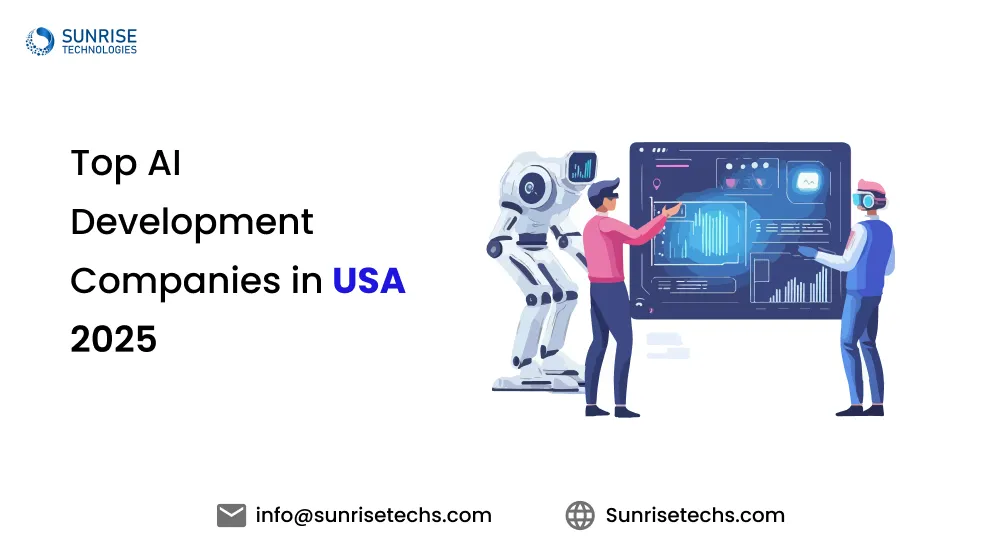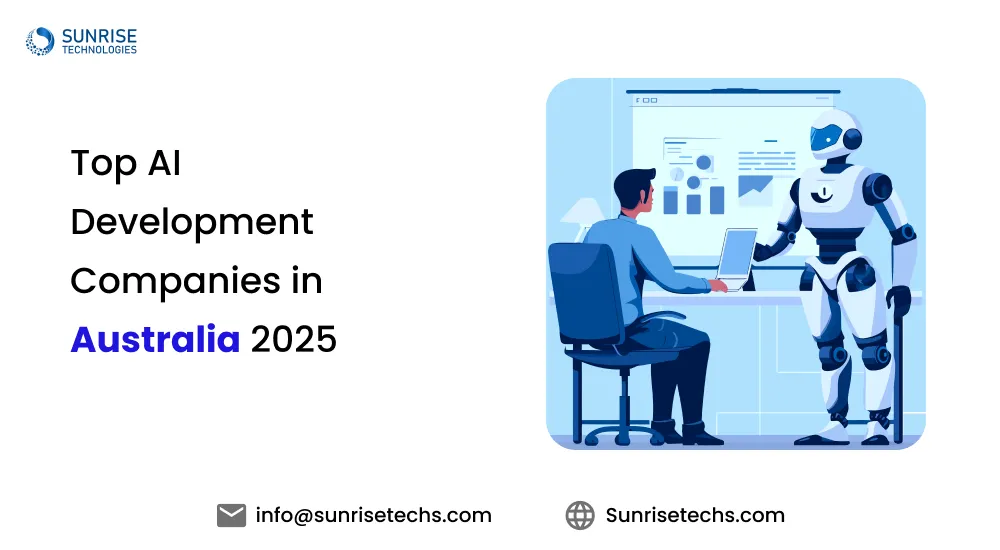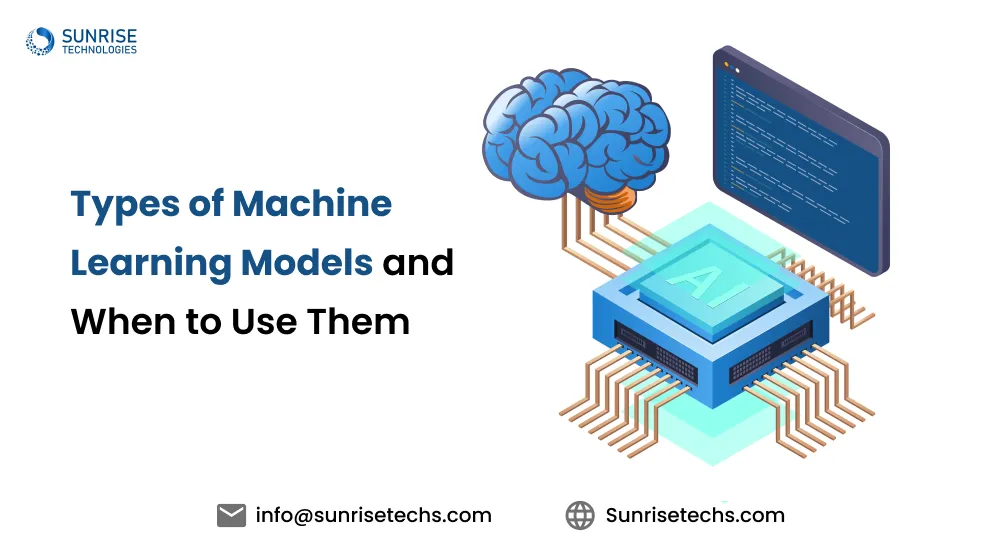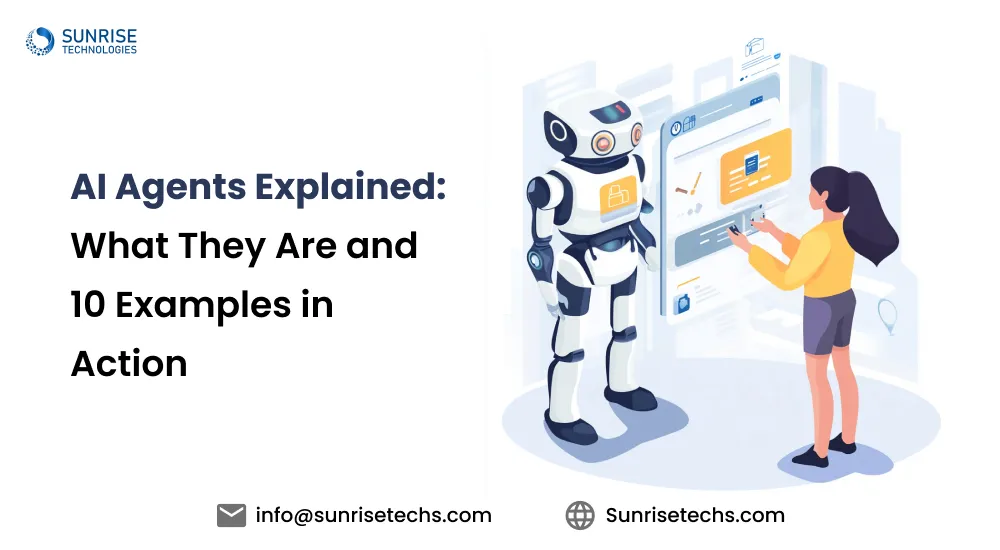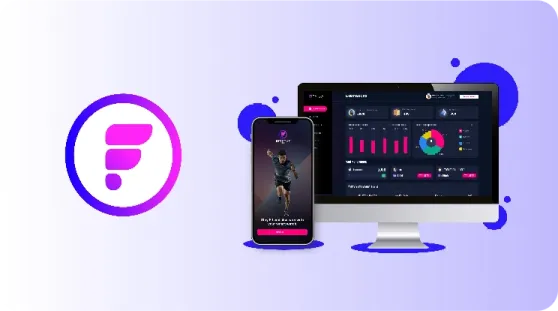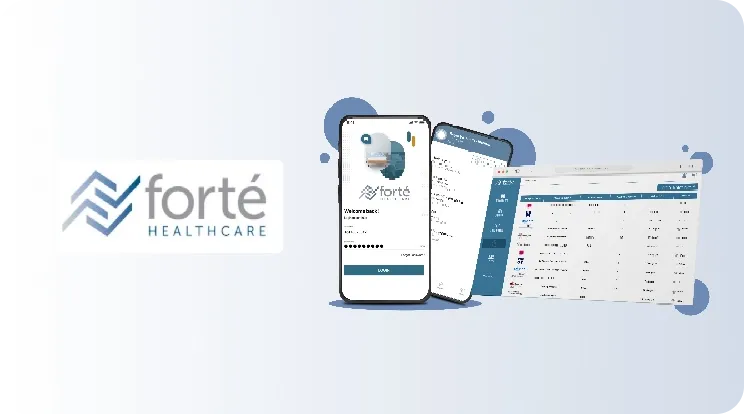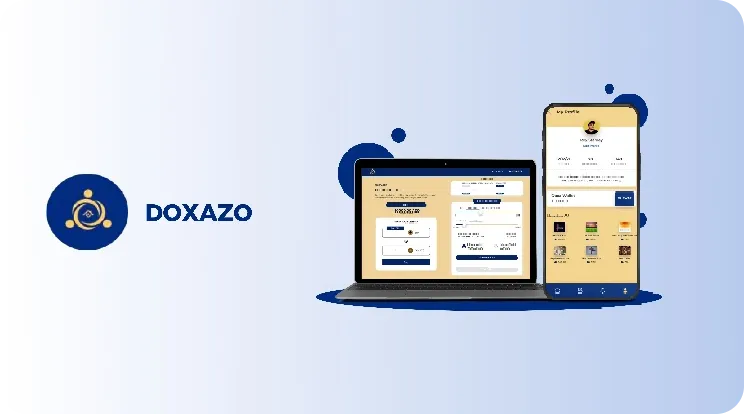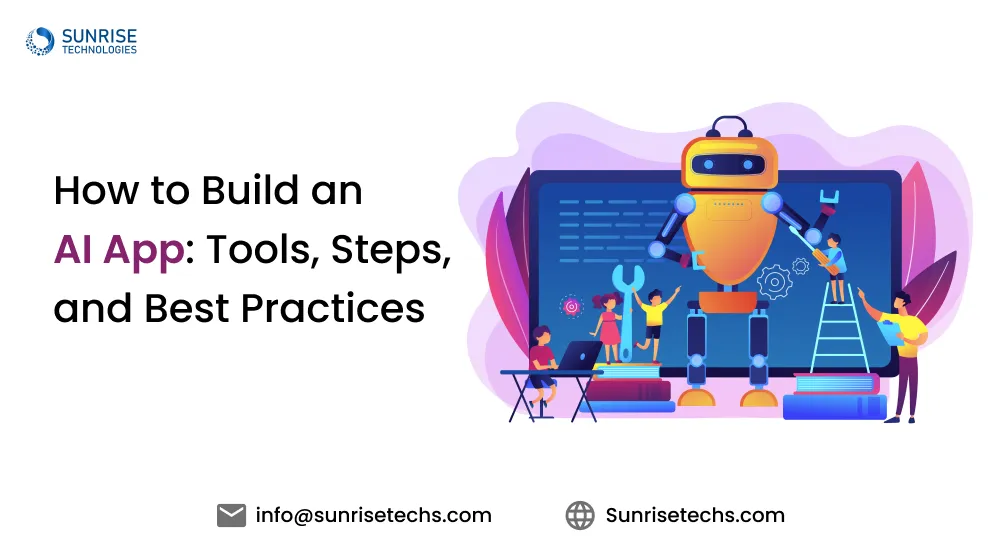
How to Build an AI App: Tools, Steps, and Best Practices
May 21, 2025
The AI app development landscape is exploding. According to a report by Grand View Research, the global AI market size is expected to reach a staggering $1.81 trillion by 2030, expanding at a compound annual growth rate (CAGR) of 38.1% from 2023 to 2030. This meteoric rise is fueled by the increasing demand for automation, predictive analytics, and intelligent decision-making in every industry.Startups, scaleups, and Fortune 500 companies alike are racing to integrate AI into their digital strategies.
For startups and enterprises, aiming to disrupt industries, knowing how to build an AI app from scratch is the first step toward creating smart, scalable, and user-centric solutions that make a real impact. This guide walks you through everything you need to know, from understanding core AI concepts to selecting the right tools and following proven best practices.
What is AI, and what are the components of AI?
At its core, Artificial Intelligence (AI) is the science and engineering of making intelligent machines, particularly intelligent computer programs. It’s about creating systems that can perform tasks that typically require human intelligence, such as learning, problem-solving, decision-making, and understanding natural language. Building an AI app requires understanding its fundamental components:

The lifeblood of any AI system. Large, high-quality datasets are essential for training AI models.
The set of rules and statistical techniques used by AI models to learn from data and make predictions or decisions. Machine learning (ML) algorithms are a core component.
Training complex AI models often requires significant computational resources, often leveraging GPUs or cloud-based infrastructure.
Libraries and tools that provide the necessary infrastructure for building and deploying AI models within an AI app.
Types of AI You Should Know When You Build an AI App
The field of AI is often categorized into different levels of intelligence:
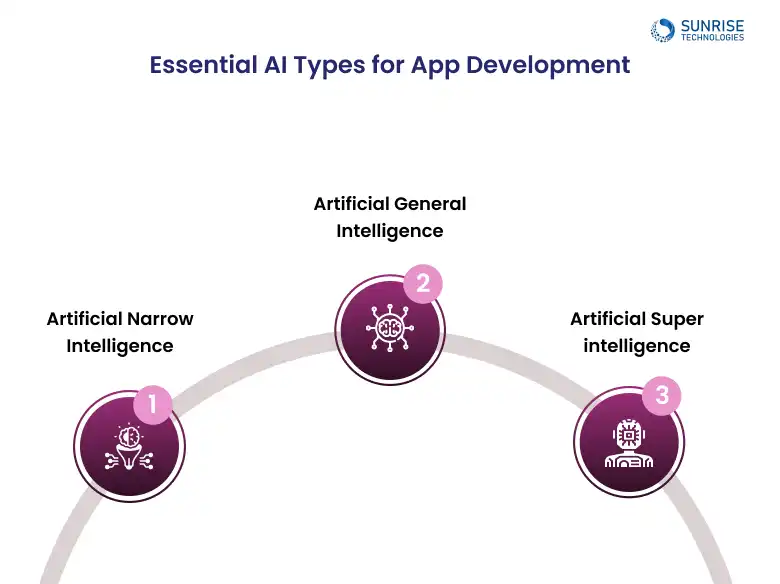
Also known as Weak AI, this type of AI excels at performing specific tasks, such as image recognition, playing chess, or understanding voice commands. Most AI apps today fall under this category.
Also known as Strong AI or Human-Level AI, this is a hypothetical type of AI with the ability to understand, learn, and apply knowledge across a wide range of tasks at a human cognitive level. AGI is still a significant research goal.
This is a hypothetical form of AI that would surpass human intelligence in virtually all cognitive domains. ASI is a highly theoretical concept and not within our current technological capabilities. When you build AI app today, you’re primarily working within the realm of ANI.
Traditional App vs. AI App: Key Differences
| Feature | Traditional App | AI App |
|---|---|---|
| Functionality | Rule-based, static responses | Learns and adapts over time |
| User Interaction | Predefined workflows | Dynamic, personalized experiences |
| Data Handling | Processes structured data | Handles both structured and unstructured data |
| Decision Making | Manual or fixed logic | Predictive and autonomous |
| Scalability | Limited by predefined rules | Scales with data and learning |
Core Elements of AI Used in Building Intelligent Applications
To effectively build an AI app, understanding the fundamental elements that power intelligent behavior is essential. These components and top frameworks for building AI applications form the building blocks for next-gen mobile and web solutions.

Here’s a breakdown of the core AI technologies used in AI app development:
A cornerstone of AI app development, Machine Learning involves training algorithms to identify patterns and make decisions based on data. Popular ML techniques include regression, classification, and clustering. These are essential when figuring out how to build a AI app from scratch that can learn and improve over time.
Deep Learning takes ML a step further, using multi-layered models to process complex datasets. It’s especially powerful for tasks like voice recognition, language translation, and video analysis. DL plays a crucial role in AI app development where unstructured data, like images or speech is involved.
At the heart of deep learning are neural networks, computational models inspired by the human brain. These networks are built from interconnected layers of nodes (neurons) that transform input data through weighted connections. Neural networks are used for everything from sentiment analysis and fraud detection to autonomous driving and medical imaging. Their ability to process large volumes of data makes them indispensable when you’re looking at how to build a AI app from scratch.
From chatbots to virtual assistants, NLP allows machines to understand, process, and generate human language. For AI apps that rely on voice commands, sentiment analysis, or smart search, libraries like spaCy, NLTK, and BERT models are game-changers.
Computer Vision brings sight to AI. It enables applications to analyze and understand images or videos, which is critical for tasks like object detection, facial recognition, and autonomous navigation. Popular tools include OpenCV, YOLO, and Vision APIs within TensorFlow.
Computer Vision brings sight to AI. It enables applications to analyze and understand images or videos, which is critical for tasks like object detection, facial recognition, and autonomous navigation. Popular tools include OpenCV, YOLO, and Vision APIs within TensorFlow.
A learning paradigm where intelligent agents make decisions by interacting with their environment, learning from rewards and penalties. RL powers AI-powered mobile apps in areas like game AI, dynamic pricing models, and robotics.
These core elements of AI, from machine learning and neural networks to computer vision and robotics are what truly differentiate a traditional app from an intelligent one. With the right frameworks and technical approach, you can create AI-powered solutions that think, adapt, and elevate the user experience.
Our experts will help you turn your AI app vision into a real, scalable product. Book a free consultation today!

Top Frameworks for Building AI Applications
When diving into AI app development, choosing the right framework is pivotal to creating a scalable and high-performance solution. Leveraging the best frameworks for AI applications can significantly accelerate your development process, ensuring that you meet your goals efficiently and with precision. Here’s a detailed look at some of the top frameworks for building AI applications:
TensorFlow is an open-source deep learning framework developed by Google, widely used for AI-powered apps. Here’s why it’s a popular choice for AI developers:
- Versatility: Suited for machine learning (ML), deep learning (DL), and neural networks.
- High Performance: Optimized for large-scale data processing and computation, ideal for building complex AI models.
- Cross-Platform Compatibility: Supports multiple platforms (mobile, web, and cloud) for AI app development.
- Comprehensive Libraries: Includes tools for image recognition, speech recognition, and more.
PyTorch is a deep learning framework that offers dynamic computation graphs, making it great for rapid experimentation and research. Here’s why PyTorch stands out:
- Dynamic Graphs: Supports real-time adjustments and easier debugging compared to static graph frameworks.
- Research-Friendly: Preferred by researchers and developers for prototyping due to its flexibility.
- Deep Learning Excellence: Best for building complex models involving neural networks, computer vision, and NLP.
- Community Support: With a large, active community, PyTorch constantly evolves with new features.
Keras is a high-level deep learning framework that runs on top of TensorFlow, making it user-friendly and efficient for building deep learning models. Here’s why Keras is a go-to choice for many:
- Simplified Interface: Provides an intuitive API for quick development of deep learning models.
- Built on TensorFlow: Leverages the power of TensorFlow while offering an easier interface for developers.
- Speedy Prototyping: Enables rapid experimentation without sacrificing performance.
- Wide Usage: Commonly used for tasks like image classification and speech recognition.
Scikit-learn is one of the most widely used libraries for traditional machine learning. While it isn’t as focused on deep learning, it’s perfect for various classical ML tasks. Here’s why developers love it:
- Traditional ML Algorithms: Ideal for algorithms like classification, regression, clustering, and more.
- Ease of Use: Easy-to-use API, making it great for beginners and quick ML app development.
- Data Preprocessing: Includes powerful tools for data cleaning, transformation, and feature selection.
- Lightweight: Suitable for building applications that don’t require heavy computational resources.
The OpenAI API provides access to powerful language models, such as GPT-4, that can generate human-like text and understand natural language. Here’s why it’s a great choice for building AI apps:
- Advanced NLP Models: Access to top-tier models for tasks like text generation, sentiment analysis, and chatbots.
- Scalability: Easily scale your AI app with the OpenAI API’s cloud-based infrastructure.
- Integration Ease: Integrates seamlessly into mobile and web applications.
- AI-Driven Conversations: Build advanced conversational agents, virtual assistants, or AI-driven customer support bots.
How to Build an AI App from Scratch: Step-by-Step
Building an AI app from scratch requires a structured approach, combining technical expertise and creative problem-solving. Below, we break down the steps to create an AI-powered apps and guide you through the AI app development process.
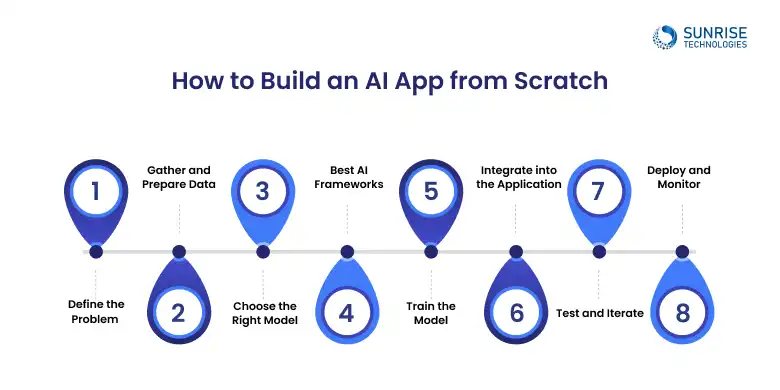
Step 1: Define the Problem
The first and most important step in building an AI app is defining the problem your app will solve. Understanding the pain points of your target audience helps determine the scope and focus of the app. Ask yourself:
- What real-world issue does my app aim to address?
- How will AI improve the user experience or efficiency?
A well-defined problem leads to a clear AI app development path, ensuring the app delivers practical and actionable results. (How to build an AI app from scratch) begins by ensuring that you’re building something meaningful and useful.
Once the problem is defined, the next critical step is gathering data. AI algorithms learn from data, so the quality and quantity of your data determine the success of your model. Consider:
- Collecting diverse and relevant data that represents the problem space.
- Cleaning the data to remove noise and inconsistencies.
- Preprocessing the data (e.g., normalization, encoding) to ensure it’s ready for training.
The data gathering and preprocessing phase sets the foundation for building a robust AI model and, ultimately, your AI app. A well-prepared dataset enhances the model’s ability to perform accurately.
Selecting the right AI model is essential for your app’s functionality. Depending on the problem, you can choose from several types of AI models:
Supervised Learning Models (e.g., classification, regression) for tasks like image recognition or fraud detection.
- Unsupervised Learning Models for clustering and pattern discovery.
- Reinforcement Learning Models for decision-making in dynamic environments.
The framework you select can impact training speed, scalability, and ease of integration. Here are some widely used options:
- TensorFlow: Backed by Google, this open-source framework is ideal for building and deploying deep learning models at scale.
- PyTorch: Known for its dynamic computation graph, PyTorch is preferred for flexibility and research-oriented projects.
- Keras: A high-level API that simplifies deep learning tasks, often used on top of TensorFlow for rapid prototyping.
- Scikit-learn: Excellent for traditional machine learning tasks like regression, classification, and clustering.
- OpenCV: Specifically useful for computer vision use cases, offering real-time image processing capabilities.
Once you’ve selected your AI model, the next step is to train it using the prepared data. This is where the real magic of AI app development happens:
- Use training data to teach the model the relationship between input and output.
- Adjust hyperparameters (like learning rate, batch size) to optimize performance.
- Evaluate the model with a validation set to check how well it generalizes to new, unseen data.
With the model trained, it’s time to integrate it into your app. This stage involves:
- Embedding the model into the app architecture.
- Ensuring that the model interacts smoothly with other app components (such as the UI/UX).
- Building an interface for real-time interactions, such as predictions or recommendations.
Integrating AI into your app transforms it from just a software solution into an intelligent one, providing enhanced features like personalization, real-time analytics, or automated decision-making.
Before launching your AI-powered app, it’s important to conduct thorough testing. This includes:
- Performance Testing: Ensuring the app performs efficiently and scales well.
- Model Testing: Verifying the model’s predictions or actions align with real-world data.
- User Testing: Collecting feedback from end-users to identify pain points and areas for improvement.
Building AI apps is an iterative process. Based on testing results, you may need to refine both the app design and the AI model for optimal functionality.
After testing and final adjustments, it’s time to deploy your AI app. However, building an AI app doesn’t stop here:
- Launch the app to a broader audience.
- Continuously monitor the app’s performance and user engagement.
- Use user feedback and app performance metrics to make updates and improvements. Ongoing monitoring ensures your app continues to evolve, providing value to users while adapting to new data or requirements.
Use our free AI app cost calculator to get a quick and realistic budget estimate based on your needs.
Industries Leveraging AI Apps for Business Transformation
Businesses across industries are adopting AI-driven applications to solve complex challenges, automate tasks, and unlock new revenue streams. Let’s explore how different sectors are embracing this revolution and how industries leveraging AI apps are reshaping business landscapes.

AI apps in the healthcare industry are significantly improving diagnosis, treatment, and patient care:
- Medical diagnostics: AI models powered by deep learning analyze medical images such as MRIs and CT scans for early disease detection, helping radiologists reduce diagnostic errors. Example: Google Health’s AI outperformed radiologists in detecting breast cancer.
- Patient monitoring: Wearable devices and health apps use AI to continuously monitor vital signs, detect anomalies, and alert doctors in real-time.
- Drug discovery: AI algorithms speed up drug research by analyzing biological and chemical data to identify potential compounds, reducing R&D costs and timelines.
- Scikit-learn: Excellent for traditional machine learning tasks like regression, classification, and clustering.
- OpenCV: Specifically useful for computer vision use cases, offering real-time image processing capabilities.
AI app development in finance is reshaping how institutions manage risk, serve customers, and ensure security:
- Fraud detection: AI apps use machine learning algorithms to analyze fraud detection, transaction patterns in real-time, flagging suspicious activities. Example: PayPal reduced its fraud rate to just 0.32% of revenue using AI-driven risk models.
- Robo-advisors: Apps like Betterment and Wealthfront use AI to offer automated, algorithm-based portfolio management with little to no human intervention.
- Credit scoring: AI evaluates creditworthiness by analyzing alternative data (e.g., utility bills, transaction history), enabling financial access for underbanked populations.
The retail industry is one of the fastest adopters of AI-based mobile applications for customer engagement and operational efficiency:
- Personalized recommendations: AI analyzes user behavior and preferences to recommend products, a strategy used extensively by Amazon and Netflix.
- Inventory optimization: AI apps predict demand patterns, reduce overstocking, and minimize out-of-stock incidents using predictive analytics.
- Visual search & smart checkout: Computer vision-enabled apps allow customers to search using images and check out without waiting in lines, as seen in Amazon Go stores.
The manufacturing sector is rapidly embracing AI applications in Industry 4.0 to enhance productivity, reduce downtime, and improve quality control.
- Predictive maintenance: By analyzing IoT sensor data, AI models predict when machinery might fail, allowing for proactive repairs and minimizing costly unplanned downtimes.
- AI-driven quality control: Real-time image processing systems inspect every product on the line to identify surface defects, irregularities, or missing parts, ensuring consistent quality standards.
- AI for supply chain optimization: Advanced forecasting algorithms assess historical trends, current demand, and external factors (like raw material availability) to automate procurement, production planning, and inventory management.
AI in Education is enabling more effective and accessible learning through smart apps:
- Adaptive learning: AI personalizes content delivery based on a student's performance, learning style, and pace. Platforms like Squirrel AI tailor education for every learner.
- Virtual tutors: Apps powered by natural language processing (NLP) simulate human-like tutoring experiences for students around the globe.
- Automated grading: AI streamlines the evaluation process for multiple-choice and even short-answer tests, saving educators time.
AI-Powered Real-Time Threat Detection and Prevention in the age of digital transformation. AI-powered cybersecurity solutions are vital for protecting critical infrastructure and sensitive data.
- Anomaly detection: Machine learning algorithms learn the baseline of normal user or system behavior and instantly detect deviations, identifying insider threats or zero-day attacks.
- Phishing prevention: AI scans emails for suspicious language patterns, URLs, and metadata, blocking socially engineered attacks before they reach the inbox.
- Threat intelligence automation: By analyzing vast datasets of past attacks and current threat landscapes, AI can predict and prioritize potential vulnerabilities, allowing security teams to respond proactively.
AI apps are fueling innovation and automation across the transportation sector:
- Autonomous driving: Self-driving vehicles rely on computer vision and reinforcement learning to detect objects, make decisions, and navigate complex environments.
- Fleet optimization: Logistics companies use AI apps to plan the most efficient routes, reduce fuel costs, and improve delivery times.
- Predictive maintenance: AI apps analyze sensor data from vehicles to detect potential failures before they occur, reducing downtime and operational costs.
AI in logistics and supply chain management is unlocking new levels of operational efficiency and responsiveness.
- Demand forecasting: Machine learning analyzes seasonal trends, purchase patterns, and macroeconomic indicators to predict demand more accurately, optimizing stock levels and reducing waste.
- Warehouse automation: Autonomous mobile robots (AMRs) and AI-guided systems handle tasks like picking, sorting, and inventory tracking, significantly reducing human error and speeding up fulfillment.
- AI-based delivery route optimization: Real-time data from GPS, weather APIs, and traffic systems feed AI algorithms that continuously adjust routes for fastest, most fuel-efficient delivery paths.
Personalized Experiences through AI-Driven Travel Applications. The travel and tourism sector is leveraging AI-powered travel apps to deliver more personalized, seamless journeys for users.
- Smart itinerary planning with AI algorithms: These apps curate dynamic travel plans based on preferences, location history, budget, and even current travel trends, making trip planning effortless.
- AI travel assistants and chatbots: Available 24/7, these NLP-powered bots help with flight rescheduling, hotel bookings, and real-time destination tips, enhancing user satisfaction.
- Augmented reality (AR) and image recognition: Travelers can point their phones at landmarks to receive historical information, nearby attractions, or translations, enriching the experience.
Personalized, AI-Powered Content and Creation,with the rise of digital content, and AI in media and entertainment is redefining how stories are told and consumed.
- AI-powered content recommendation engines: Platforms like Netflix and Spotify use collaborative filtering, deep learning, and user behavior analytics to surface content that aligns with user tastes.
- Synthetic media creation with AI: Deepfake technology and voice cloning tools allow creators to build lifelike avatars and voices for films, games, and marketing, pushing creative boundaries.
- AI-assisted video editing software: These tools automatically detect highlights, add effects, generate subtitles, and even suggest scenes to cut or emphasize, drastically reducing editing time.
Key Benefits of AI App Development for Businesses and Startups
Embracing AI app development unlocks a range of transformative benefits for both startups and enterprises. Whether you’re building an internal tool or a consumer-facing product, AI integration enhances performance and user satisfaction.
AI-powered applications use machine learning models to understand user behavior and preferences.
- Apps like Spotify or Amazon Prime recommend content based on real-time analytics.
- AI personalizes interactions, interfaces, and suggestions, creating a tailored user journey.
Automating routine or repetitive tasks (e.g., chat responses, report generation) with AI significantly reduces human workload.
- NLP bots manage customer service at scale.
- AI systems monitor performance and trigger alerts or actions without human intervention.
AI in apps enables real-time analytics and predictions by processing large datasets efficiently.
- Predictive analytics helps businesses forecast sales, churn, or demand trends.
- Deep learning models recognize patterns beyond human capability.
Cloud-based AI models can adapt to growing user demands without major architectural overhauls.
- AutoML and scalable APIs ensure your AI functionality evolves with user growth.
- Microservice architecture supports modular and flexible expansion.
Ensure you’re using the right tools, frameworks, and steps to build a powerful AI application. Free download available!
Real-World AI Application Use Cases Across Industries
AI Models Used: Natural Language Processing (NLP), Recurrent Neural Networks (RNN)
Focus Keywords: AI-powered chatbots, NLP, AI app development H&M, a global retail giant, integrated an AI-powered chatbot into their customer service strategy to improve response times and enhance customer interactions. By implementing Natural Language Processing (NLP) and Recurrent Neural Networks (RNN), the chatbot could understand customer inquiries in real-time and provide personalized responses. This integration enabled H&M to reduce customer service response time drastically, improve customer satisfaction, and increase sales by offering tailored recommendations to online shoppers.
AI Models Used: Machine Learning (ML), Time Series Analysis, Anomaly Detection
Focus Keywords: Predictive maintenance, AI in manufacturing, machine learning models General Electric (GE) implemented predictive maintenance in its industrial operations, using AI models to monitor the health of equipment in real-time. By leveraging Machine Learning (ML) algorithms and Time Series Analysis, GE’s system predicts failures before they occur, saving millions of dollars in downtime and repairs. GE uses Anomaly Detection techniques to identify any outlier patterns in the equipment data and trigger maintenance alerts to prevent breakdowns. This has not only improved operational efficiency but also extended the lifespan of critical machinery across their operations worldwide.
AI Models Used: Computer Vision, Convolutional Neural Networks (CNN), Image Recognition Models
Focus Keywords: AI-powered visual search, computer vision, retail AI applications Walmart, a leading global retailer, launched an AI-powered visual search feature in their mobile app, allowing customers to search for products by uploading images. The system uses Computer Vision technology and Convolutional Neural Networks (CNN) to analyze images and find similar products within Walmart’s inventory. This AI feature has significantly boosted customer engagement, as shoppers can now easily discover and purchase products they find in-store or online. Walmart’s implementation of image recognition models has enhanced the overall shopping experience and helped them stand out in the competitive retail space.
AI Models Used: Machine Learning (ML), Anomaly Detection, Behavioral Analytics
Focus Keywords: Fraud detection, AI in finance, machine learning Mastercard, a global leader in the payments industry, uses AI-powered fraud detection systems to monitor and analyze transaction data in real-time. By leveraging Machine Learning (ML) and Anomaly Detection models, Mastercard can quickly identify and prevent fraudulent activities. This AI solution examines spending patterns, detects deviations from typical behaviors, and flags potential fraud attempts. Mastercard’s system also continuously learns from new transaction data, improving its ability to detect sophisticated fraud methods, thus enhancing security and customer trust in digital payments.
With the right tools and a proven roadmap, success is within reach.
AI App Development Best Practices for Startups
For startups entering the world of AI application development, following AI app best practices with strategic planning and technical discipline is key. Here’s a roadmap to get it right:
Avoid overengineering. Focus on core AI functionalities first.
- Test with real users, gather early feedback, and iterate fast.
- MVPs are crucial for validating the usefulness of your AI feature before scaling.
Garbage in, garbage out, your AI is only as smart as the data it learns from.
- Clean, labeled, and context-rich datasets improve training accuracy.
- Data pre-processing (e.g., normalization, outlier handling) is often more important than the model itself.
AI models improve over time with feedback and retraining.
- Use performance metrics (accuracy, F1 score) to monitor model behavior.
- Implement continuous learning loops where your AI learns from new user interactions.
Ensure your AI respects user privacy and adheres to data protection laws like GDPR or HIPAA.
- Explainability (why AI made a decision) matters in regulated industries.
- Include opt-ins, anonymization, and audit trails in your architecture.
Think ahead, your AI app will likely evolve.
- Use containerized models (e.g., with Docker) and scalable cloud platforms (like AWS SageMaker).
- Design APIs and data pipelines that accommodate growth without re-engineering the entire system.
AI App Builder vs. Custom AI Development: What’s Right for You?
If you’re a startup or small business looking to experiment with AI, an AI app builder can be a quick and cost-effective solution. These platforms offer pre-built components and drag-and-drop interfaces to prototype or even launch simple AI-driven applications. However, for more scalable, domain-specific, or complex solutions, custom AI development provides the flexibility and performance that out-of-the-box builders may lack.
Best Tools for AI App Development
Discover the best AI app tools that streamline development, enhance performance, and accelerate your AI app journey.
| Framework | Key Features | Best For | Popular Use Cases |
|---|---|---|---|
| TensorFlow |
– Open-source – High performance – Cross-platform support |
Deep learning, neural networks, image & speech recognition |
– Image recognition – Speech recognition – NLP |
| PyTorch |
– Dynamic computation graph – Research-friendly – Deep learning |
Prototyping, deep learning, research |
– Computer vision – NLP – Research prototyping |
| Keras |
– High-level API – Built on TensorFlow – Fast prototyping |
Rapid development of deep learning models |
– Image classification – Speech recognition |
| Scikit-learn |
– Lightweight – Traditional ML algorithms – Easy-to-use API |
Machine learning (classification, regression, clustering) |
– Data mining – Classification tasks – Clustering |
| OpenAI API |
– Powerful language models (GPT-4) – Cloud-based – Easy integration |
NLP applications, chatbots, text generation |
– Chatbots – Virtual assistants – Sentiment analysis |
How Sunrise Helps in AI App Development for Businesses and Startups
When it comes to building intelligent, scalable, and impactful applications, Sunrise Technologies AI app development services are tailored to accelerate innovation from idea to launch. Here’s how we bring value at every stage:
Every successful AI app starts with a well-defined strategy.
- Sunrise provides expert consultation to evaluate your app idea, understand your data sources, and assess model feasibility.
- We help identify the most suitable AI models, frameworks, and data pipelines based on your business goals.
From model development to deployment, we handle it all.
- Our team develops AI models using state-of-the-art frameworks like TensorFlow, PyTorch, and Scikit-learn.
- We ensure smooth integration into mobile or web apps with RESTful APIs, containerization (Docker), and scalable cloud platforms (AWS, GCP, Azure).
AI isn’t a one-time implementation.
- We provide ongoing model monitoring, retraining, and version control to ensure high performance over time.
- Our support includes infrastructure updates, performance tuning, and new feature rollouts.
Whether you’re a startup validating a prototype or an enterprise scaling a product, partnering with Sunrise fast-tracks your development lifecycle.
- With cross-functional teams including data scientists, developers, and UI/UX experts, we ensure your app is not just smart, but usable and scalable.
The Future of AI App Development: Trends and Technologies to Watch
The evolution of AI application development is set to redefine how apps function, becoming more intelligent, responsive, and privacy-aware. Forward-thinking businesses need to stay aligned with emerging trends to stay competitive.
AI models running directly on edge devices (e.g., smartphones, IoT hardware) eliminate cloud latency and boost responsiveness.
- Ideal for real-time decision-making in healthcare, automotive, and manufacturing apps.
- Tools like NVIDIA Jetson or Google Edge TPU are shaping this space.
Instead of sending raw user data to a central server, federated learning trains models locally on devices.
- This approach enhances privacy and complies with data regulations like GDPR.
- It’s increasingly used in healthcare, finance, and personal assistant apps.
As AI systems become more complex, users demand explanations.
- XAI enables model interpretability and helps build user trust, especially critical in finance, healthcare, and legal tech.
- Frameworks like LIME and SHAP are gaining adoption.
Wrapping Up: A Strategic Guide to Successful AI App Development
Embarking on AI app development is more than just a tech trend, it’s a forward-looking business strategy that unlocks innovation, automation, and growth. By understanding the foundational concepts of AI, selecting the right machine learning models, and leveraging frameworks like TensorFlow or PyTorch, developers and startups can build applications that are not only intelligent but also impactful.
Staying focused on AI app development best practices for startups, from data quality and ethical AI design to scalable architecture ensures that your app performs well today and adapts to tomorrow’s needs.
With the right AI app development Services like Sunrise Technologies, you don’t just build apps, you build intelligent experiences that evolve, learn, and lead. Ready to start your AI journey?
We simplify the tech and amplify the results by combining cutting-edge tools, tailored strategies, and seamless integration. Let’s build brilliance together.
To build an AI app, you'll need tools such as TensorFlow, PyTorch, Keras for model development, and scikit-learn for machine learning tasks. Additionally, cloud services like AWS AI or Google Cloud AI can provide scalable infrastructure.
The time it takes to develop an AI app depends on its complexity. Simple apps may take a few weeks, while more sophisticated applications could take several months due to training data preparation, model development, and integration.
To train a model for an AI app, you'll need to:
- Gather and preprocess data.
- Select the appropriate machine learning or deep learning model.
- Train the model using your data, and continuously adjust hyperparameters to optimize its performance.
The cost typically ranges from $20,000 to $200,000+, depending on app complexity, features, industry needs, and whether you use an AI app builder or go for custom development.
Some key best practices for AI app development include:
- Start small by creating a Minimum Viable Product (MVP).
- Ensure clear goals and metrics for success.
- Use clean, labeled, and balanced datasets.
- Monitor performance continuously post-deployment.
- Stay updated with the latest frameworks and libraries.
Sam is a chartered professional engineer with over 15 years of extensive experience in the software technology space. Over the years, Sam has held the position of Chief Technology Consultant for tech companies both in Australia and abroad before establishing his own software consulting firm in Sydney, Australia. In his current role, he manages a large team of developers and engineers across Australia and internationally, dedicated to delivering the best in software technology.



